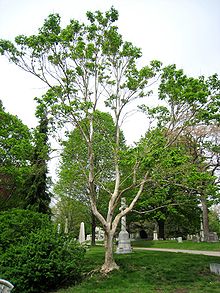Heptacodium

Heptacodium miconioides, the seven son flower, is a species of flowering plant. It is the sole species in the monotypic genus Heptacodium, of the honeysuckle family Caprifoliaceae. The common name “seven son flower” is a direct translation of the Standard Chinese name 七子花 qi zi hua.
Endemic to China, this species was discovered for Western horticulture in 1907 by the British plant hunter Ernest Wilson on behalf of the Arnold Arboretum. It was growing on mountain cliffs at ‘Hsing-Shan Hsien’ in present day Xingshan County in the west of Hubei Province in central China.[3][4] Considered rare even at that time, only nine populations are known to remain in the wild (e.g. one on Tiantai Mountain),[4] all of them in Anhui and Zhejiang provinces and threatened by habitat loss.[5] The species is now under second-class national protection in China.[6] The Sino-American Botanical Expedition of 1980[7] collected viable seeds and sent them to the Arnold Arboretum where it was found to be readily cultivated. The plant is now grown as an ornamental around the world.
Heptacodium miconioides is a deciduous large shrub or small tree, typically growing to a height of 4–9 m (13–30 ft). The bark of the trunk is papery and thin, light tan in colour, and exfoliates in strips or sheets. The upright, spreading, quadrangular branches give the plant a rounded, often irregular shape. The dark-green cordate leaves are opposite, 8–10 cm long by 5–6 cm wide, with entire margins and deeply impressed venation running parallel to the margin.[7] In September, H. miconioides produces large shows of small fragrant white blooms attractive to butterflies and bumblebees,[8] the flowers five-petalled, < 13 mm across.[9] When the white corollas have fallen, the calyces develop into deep red expanded lobes which persist into November. The plant may be found in scrub, woodlands, and on the margins of broadleaved evergreen forests, often on cliffs, at altitudes of 600-1000 metres.[10]
